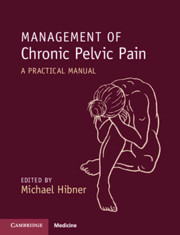Book contents
- Management of Chronic Pelvic Pain
- Management of Chronic Pelvic Pain
- Copyright page
- Contents
- Contributors
- Foreword
- Chapter 1 Introduction to Chronic Pelvic Pain
- Chapter 2 Neurobiological Basis of Pelvic Pain
- Chapter 3 History and Evaluation of Patients with Chronic Pelvic Pain
- Chapter 4 Psychological Assessment of a Female Patient with Chronic Pelvic Pain
- Chapter 5 Musculoskeletal Assessment for Patients with Pelvic Pain
- Chapter 6 Pharmacological Management of Patients with Pelvic Pain
- Chapter 7 Evidence for Surgery for Pelvic Pain
- Chapter 8 Pelvic Pain Arising from Endometriosis
- Chapter 9 Bladder Pain Syndrome
- Chapter 10 Pelvic Pain Arising from Pelvic Congestion Syndrome
- Chapter 11 Irritable Bowel Syndrome
- Chapter 12 Vulvodynia
- Chapter 13 Pelvic Pain Arising from Adhesive Disease
- Chapter 14 Pelvic Pain Arising from Ovarian Remnant Syndrome
- Chapter 15 Pudendal Neuralgia
- Chapter 16 Other Peripheral Pelvic Neuralgias
- Chapter 17 Chronic Pain After Gynecological Surgery
- Chapter 18 Pain Arising from Pelvic Mesh Implants
- Chapter 19 Treatment of Sexual Dysfunction Arising from Chronic Pelvic Pain
- Chapter 20 Physical Therapy Interventions for Musculoskeletal Impairments in Pelvic Pain
- Chapter 21 If Everything Else Fails
- Index
- References
Chapter 10 - Pelvic Pain Arising from Pelvic Congestion Syndrome
Published online by Cambridge University Press: 08 March 2021
- Management of Chronic Pelvic Pain
- Management of Chronic Pelvic Pain
- Copyright page
- Contents
- Contributors
- Foreword
- Chapter 1 Introduction to Chronic Pelvic Pain
- Chapter 2 Neurobiological Basis of Pelvic Pain
- Chapter 3 History and Evaluation of Patients with Chronic Pelvic Pain
- Chapter 4 Psychological Assessment of a Female Patient with Chronic Pelvic Pain
- Chapter 5 Musculoskeletal Assessment for Patients with Pelvic Pain
- Chapter 6 Pharmacological Management of Patients with Pelvic Pain
- Chapter 7 Evidence for Surgery for Pelvic Pain
- Chapter 8 Pelvic Pain Arising from Endometriosis
- Chapter 9 Bladder Pain Syndrome
- Chapter 10 Pelvic Pain Arising from Pelvic Congestion Syndrome
- Chapter 11 Irritable Bowel Syndrome
- Chapter 12 Vulvodynia
- Chapter 13 Pelvic Pain Arising from Adhesive Disease
- Chapter 14 Pelvic Pain Arising from Ovarian Remnant Syndrome
- Chapter 15 Pudendal Neuralgia
- Chapter 16 Other Peripheral Pelvic Neuralgias
- Chapter 17 Chronic Pain After Gynecological Surgery
- Chapter 18 Pain Arising from Pelvic Mesh Implants
- Chapter 19 Treatment of Sexual Dysfunction Arising from Chronic Pelvic Pain
- Chapter 20 Physical Therapy Interventions for Musculoskeletal Impairments in Pelvic Pain
- Chapter 21 If Everything Else Fails
- Index
- References
Summary
Pelvic congestion syndrome is another condition causing pelvic pain for which there is no consensus on diagnosis or treatment; moreover, some physicians don’t even believe it causes pelvic pain. Pain from pelvic congestion is multifactorial and may be caused by hypoxia and mechanical stretching of pelvic veins. It usually occurs after pregnancy (may be full term, ectopic, or miscarriage) and presents as a sensation of heaviness in the lower abdomen with upright body position. On the background of this sensation there is intermittent sharp lower pelvic pain. In our practice we diagnose pelvic pain based on symptoms but confirm it with transfundal venography preformed in the operating room immediately prior to surgery. We treat pelvic congestion syndrome either by referring the patient to interventional radiology for embolization of the pelvic veins or by surgical selective pelvic vein ligation. In this procedure we separate ovarian veins from arteries and legate them and then legate any significantly enlarged veins in the broad ligament. Outcomes from this treatment are effective; however, pain and congestion may return with time, especially if the patient becomes pregnant again.
- Type
- Chapter
- Information
- Management of Chronic Pelvic PainA Practical Manual, pp. 112 - 119Publisher: Cambridge University PressPrint publication year: 2021
References
- 1
- Cited by



